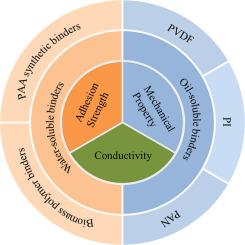锂离子电池的先进阴极粘合剂:分子设计和性能增强
IF 7.1
Q1 ENGINEERING, CHEMICAL
引用次数: 0
摘要
聚合物粘合剂作为锂离子电池(LIBs)的重要组成部分,其基本目的是将活性颗粒和导电剂有效地结合到集流器上,从而确保电极的结构完整性和稳定性。聚偏氟乙烯(PVDF)是一种传统的阴极粘结剂,在锂离子电池中得到了广泛的应用,但它面临着粘附性有限、机械强度不足、离子电导率差等重大挑战。因此,研究人员致力于开发具有更好的附着力、稳定性和导电性的多功能聚合物粘合剂,以满足先进lib对性能、成本效益和环境可持续性日益增长的需求。本文系统地综述了阴极粘结剂技术的最新进展,包括:(1)油溶性和水溶性粘结剂体系的比较分析及其各自对不同阴极材料的影响机制;(2)系统总结和分析功能性导电粘结剂的必要性和制备方法。最后,展望了新一代粘合剂的发展前景和面临的挑战。本文章由计算机程序翻译,如有差异,请以英文原文为准。

Advanced cathode binders for lithium-ion batteries: Molecular design and performance enhancement
As essential components in lithium-ion batteries (LIBs), polymer binders serve the fundamental purpose of effectively binding active particles and conductive agents to the current collector, thereby ensuring the structural integrity and stability of the electrodes. Although polyvinylidene fluoride (PVDF), the conventional cathode binder, is extensively utilized in lithium-ion batteries, it faces significant challenges, including limited adhesion, insufficient mechanical strength, and poor ionic conductivity. In response, significant research efforts are directed toward developing multifunctional polymer binders with improved adhesion, stability, and conductivity to satisfy the increasing demands for performance, cost-effectiveness, and environmental sustainability in advanced LIBs. This review systematically examines recent progress in cathode binder technology, encompassing: (1) comparative analysis of oil-soluble and water-soluble binder systems and their respective influence mechanisms on different cathode materials; (2) systematic summary and analysis of the necessity and preparation methods of functional conductive binders. Finally, we outline the future development prospects and challenges in next-generation binder development.
求助全文
通过发布文献求助,成功后即可免费获取论文全文。
去求助
来源期刊

Chemical Engineering Journal Advances
Engineering-Industrial and Manufacturing Engineering
CiteScore
8.30
自引率
0.00%
发文量
213
审稿时长
26 days
 求助内容:
求助内容: 应助结果提醒方式:
应助结果提醒方式:


